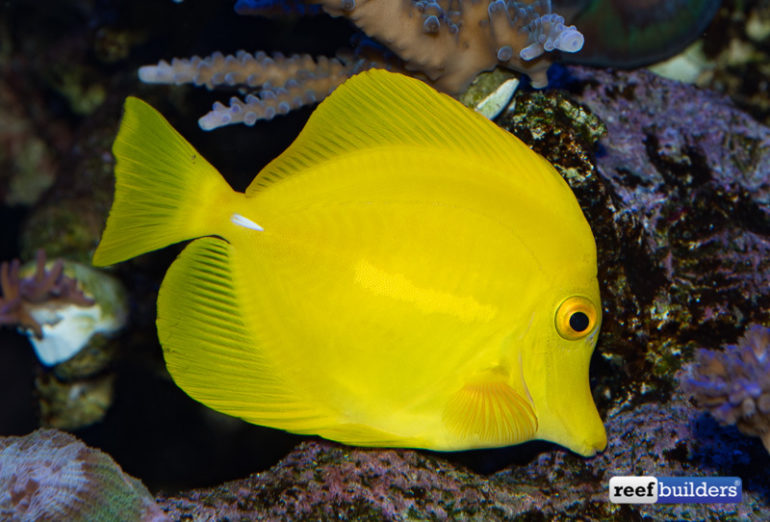The State of Hawaii Bill calling to prohibit the harvesting of aquatic life for commercial aquarium purposes was voted down by one of the committees. Bill 505 was the latest significant hurdle serving to prevent the capture of Hawaiian saltwater fish for ornamental aquaria which, if it had been passed, would mean no Hawaiian saltwater fish like Yellow tangs would be available, period. But we’re not celebrating yet.
Now that Bill 505 has been defeated, stakeholders can get back to what they should’ve been doing in applying to request a fishing permit from the Department of Land and Natural Resources. There are just seven permits available and they will only allow capped collection numbers of eight species of fish, of which the Yellow tang is one of them. When and if fishing permits are granted the quota of 200,000 Yellow tangs will be split equally into 28,571 fish per permit. These will then make their way through the global supply chain and hopefully end up in an aquatic store near you. But note, they haven’t been granted yet.

“This doesn’t mean we are out of the woods as there is a companion bill in the house (which has not been scheduled) and the ever-looming “gut and replace” tactic,” a source involved in the legal battle told Reef Builders. “Gut and replace” occurs when late in session a bill in Hawaii is stripped of all original content and replaced with an entirely different topic that has no rational connection to the original bill. The bill becomes unrecognizable and is pushed through the Legislature without required readings.
The tactic deprives the public of any meaningful voice in the legislative process and also deprives legislators of receiving adequate notice and time to thoroughly review the consequences of proposed legislation prior to voting, according to Common Cause Hawaii. So as ever, the whole thing is on a knife edge and we completely understand why the stakeholders who are fighting for ornamental fish collection and against the latest Bill 505 to ban it literally have to take it one day at a time and aren’t celebrating anything just yet.
The case for ornamental fish collection and opposing Bill 505 is supported by 21 of the worlds leading nearshore fishery Ph.D. qualified ecologists. They have all been intimately involved in research in Hawaii and around the world, and produced the following letter:

Scientific support letter
The 1998 law which established the West Hawaii Regional Fishery Management Area (WHRFMA) required the DLNR/DAR to present a report to the Legislature every five years on the effectiveness of the WHRFMA. To do so it was necessary to study how the new regulations were working. To accomplish this, DAR in association with the University of Hawaii Hilo, established a rigorous, scientific monitoring program in 1999 to track changes in reef fish populations and coral reef benthic communities. Over the past 20 years, 82 survey divers have conducted over 2,100 underwater surveys for this monitoring project. Additionally, a number of other scientists have conducted research in West Hawaii relating to aquarium issues and/or targeted species.
The monitoring data show that the regulations put in place have been very effective in managing aquarium collecting in West Hawaii. The West Hawaii Regional Fishery Management Area is among the best-studied and most effective fishery management efforts to date, and scientific data clearly shows that management is working with population increases of the primary targets. For example, as noted in the 2019 DLNR/DAR legislative report, the populations of the two most heavily collected species of West Hawaii aquarium fish, Yellow Tang and Kole, which collectively made up 92% of total aquarium catch in (FY17/l8), more than doubled over the past two decades. Their populations even increased in the areas open to collecting likely due to spillover from protected areas.
Concern expressed about the threat of climate changes such as coral bleaching on reefs warrants extreme caution in reviewing activities such as aquarium collecting. This concern over coral bleaching is certainly warranted but somewhat surprising given that the Department of Land and Natural Resources (DLNR) leadership has not implemented the 2017 Coral Bleaching Recovery Plan which was developed by DAR and the University of Hawaii based on the input of over 100 scientists and resource managers from around the world. The goal of the Recovery Plan was to implement management actions to promote coral recovery after bleaching in Hawaii and the scope of the Plan was much more comprehensive than just focusing on aquarium collecting.
As experienced Hawaii marine science researchers with a direct/intimate understanding of this issue, we want to re-emphasize that the strong support we are expressing for the fishery is due entirely to the survey efforts and results of the DAR research team. There is a huge amount of data and other information showing that the aquarium fishery is sustainably managed and that the system works. This type of science-based management should be a model for other fisheries in Hawaii.



